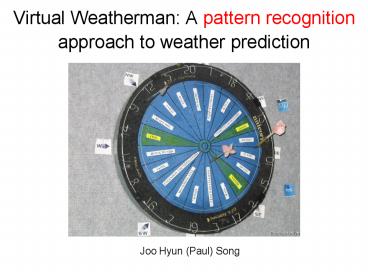Virtual Weatherman: A pattern recognition approach to weather prediction - PowerPoint PPT Presentation
1 / 17
Title:
Virtual Weatherman: A pattern recognition approach to weather prediction
Description:
Weather conditions affect transportation safety ... Mild weather fluctuations with 4 distinct seasons ... Neural network weather predictor performs fairly well ... – PowerPoint PPT presentation
Number of Views:140
Avg rating:3.0/5.0
Title: Virtual Weatherman: A pattern recognition approach to weather prediction
1
Virtual Weatherman A pattern recognition
approach to weather prediction
- Joo Hyun (Paul) Song
2
Why predict weather?
- Our daily activities often depend on weather
- Weather conditions affect transportation safety
- Using only current weather conditions to make
plans is undesirable
3
Some history
- Babylon 650 BC
- China 300 BC
- Weather lores
- 1955
- Dawn of numerical weather prediction
- Development of computers
4
Weather lores
- Solar halo or lunar corona is precursor to rain
- 60 70 accuracy
- Movement of moisture to increasingly lower levels
5
More weather lores
- Red sky at night probably means good weather
tomorrow - Low moisture level in air near the horizon
6
Modern weather forecasting
- Persistence forecasting
- Simplest method of forecasting weather
- Todays weather carries on to tomorrows weather
(works well in steady-state weather conditions) - Medium range forecasting
- Analog technique
- Pattern recognition
- Ensemble forecasting
- Uses lots of forecasts produced to reflect the
uncertainty in the initial state of the atmosphere
7
Neural Networks
- Simply variable interconnections of simple
elements - Formally nonlinear function from a set of inputs
to a set of outputs controlled by a vector of
adjustable parameters - Nonlinear
- Neural networks learn from examples and capture
subtle functional relationships among the data
even if the underlying relationships are unknown
or hard to describe
8
Neural Networks (framework)
- Weighted combinations of activation functions
- Typically chosen to be nonlinear sigmoidal
functions such as logsig or tansig - Set of weights that produce the best fit is
estimated using gradient descent
9
Dataset
- 3 locations
- Kuala Lumpur, Malaysia
- Tropical
- Small weather fluctuations
- Daily data 10/11/2001 11/30/2007
- Seoul, South Korea
- Temperate
- Mild weather fluctuations with 4 distinct seasons
- Daily data 1/1/1996 11/30/2007 (minus year
2000) - Iowa City, IA
- Hell on earth
- Meteorologists nightmare
- Daily data 4/17/2002 11/30/2007
10
Dataset (description)
- Weather Underground
- Daily weather summary of 22 parameters
- Date
- Max/min/mean temperature
- Wind speed
- Cloud cover
- Precipitation
- Events
- etc
- Hourly data also available
11
Setup
- MATLAB Neural Network Toolbox
- Input
- 10 features month, mean temp, mean dew point,
mean humidity, mean pressure, precipitation,
rain, thunderstorm, snow and fog - Past 3 days data
- Previous years data for training
- This years data for testing
- Neural Network
- 4 layer network 30-10-30-4
- purelin basis
- Resilient backpropagation training function
(trainrp) - 1000 iterations
- Output
- 4 features mean temp, mean dew point, mean
humidity and mean pressure
12
Results (Kuala Lumpur)
Actual
Predicted
RMSE 2.9049
13
(No Transcript)
14
Results (Seoul)
Actual
Predicted
RMSE 5.7240
15
Results (Hell)
Results (Iowa City)
Actual
Predicted
RMSE 6.5957
16
Conclusion
- Neural network weather predictor performs fairly
well considering small number of input features. - There was slight improvement in prediction
results if data for the corresponding season was
used to train the system. - Performance may improve with more intelligent
combination of inputs (i.e. weather conditions of
surrounding regions, etc). - Comparison to other pattern recognition schemes
such as Fuzzy set predictor may be worth
investigating. - Prediction of weather events using logsig/tansig
activation functions would be something
worthwhile to implement.
17
SORRY.NO QUESTIONS, PLEASE.































